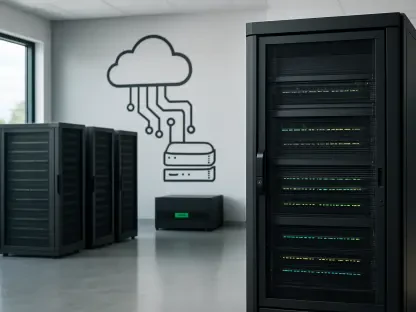As quantum computing edges closer to mainstream viability, its potential impact on current encryption methodologies cannot be overstated. The assurances that traditional encryption provides—such as safeguarding banking transactions, e-commerce dealings, and everyday communications—are under scrutiny. Quantum computing, with its unprecedented processing capabilities, poses a significant threat to the encryption methods considered unbreakable by classical computers. At the center of this seismic shift is Shor’s algorithm, which allows quantum computers to solve complex mathematical puzzles that underpin conventional encryption like RSA and elliptic curve cryptography. The urgency for cloud networks to adapt to this new reality has grown, drawing attention to both challenges and innovative solutions in encryption and data security.
The Vulnerabilities of Traditional Encryption
Evolving Threats to Established Security Protocols
Encryption has long been the linchpin of digital data protection, relying on mathematical complexities to thwart unauthorized access. Current encryption techniques like RSA function on the premise that factorizing large integers is computationally difficult for classical computers. However, quantum computers utilize principles such as superposition and entanglement to solve these problems exponentially faster. Shor’s algorithm, designed for this purpose, poses a critical challenge, rendering formerly impregnable encryption vulnerable to quantum attacks. Symmetric encryption methods such as AES-128 are not safe either; Grover’s algorithm theoretically halves the bit length required to maintain security, leaving them exposed.
Another area of concern is the “harvest now, decrypt later” tactic, where adversarial entities may intercept and store encrypted communications, waiting for the capability to decrypt them using quantum systems. Additionally, the security framework of shared cloud infrastructures, designed to maintain tenant separation through encryption, could be at risk. The potential collapse of these security boundaries highlights the need for cloud services to proactively address quantum threats, avoiding data breaches and ensuring tenant confidentiality.
Potential Threats to Authentication Protocols
The integration of quantum computing challenges is imminent not only for encryption but also for authentication protocols such as OAuth, SAML, and Kerberos. These systems are crucial for secure verification, allowing users safe access to cloud environments. Quantum advancements threaten to disrupt these systems, introducing the possibility of unauthorized access—a scenario that could compromise secure cloud interactions. If encryption fails, malicious actors could potentially impersonate users or services, leading to severe breaches of confidentiality and trust within cloud ecosystems.
A deeper implication lies in the cascading effect such breaches could have on global enterprises relying on cloud networks for operational effectiveness. Without robust authentication protocols, organizations may struggle to maintain integrity across their digital platforms, particularly in environments that handle sensitive data. The looming threat necessitates relentless innovation in updated security protocols, emphasizing the importance of integrating quantum-resilient measures into existing authentication frameworks to stave off potential breaches.
Towards Quantum-Resistant Solutions
Embracing Quantum-Resilient Cryptography
In response to the imminent threats quantum computing poses, the cybersecurity community is working diligently to develop quantum-resistant cryptographic solutions. Efforts led by the National Institute of Standards and Technology (NIST) are central to this movement. NIST has pioneered research into post-quantum cryptography, focusing on algorithms that withstand quantum decryption attempts. Approaches include lattice-based cryptography, which presents complex algebraic structures that make solving as challenging for quantum computers as it is for classical ones. Hash-based signatures and multivariate polynomial algorithms are also gaining traction, offering additional layers of protection.
These quantum-resilient cryptographic methods aim to replace or augment current encryption standards, providing a robust defense against quantum threats. Beta-testing and validation of these methods are in full swing to ensure these solutions are not only theoretically sound but practically viable for mass deployment across cloud networks. Given the urgent timeline as quantum capabilities advance, organizations are encouraged to strategize immediately and assess their systems for potential upgrades, ensuring their readiness for a quantum-compliant future.
Quantum Key Distribution and Future Innovations
Quantum Key Distribution (QKD) is another promising advancement aimed at securing communications in the quantum era. By leveraging the principles of quantum mechanics, QKD ensures secure key exchanges—detecting any eavesdropping attempts during the process. The inherent security provided by quantum principles makes QKD a compelling choice for sensitive communications, as it offers an elevated level of assurance against interception. Although practical challenges in scaling QKD may persist, its potential as a robust security measure cannot be overlooked.
Concurrent with these advancements, quantum technology itself holds opportunities for security enhancements beyond threatening existing systems. Quantum random number generators present avenues for creating truly unpredictable keys, overcoming limitations in pseudo-randomization seen in classical systems. Incorporating quantum-powered AI into security protocols is another horizon, optimizing threat detection and response mechanisms. As these technologies mature, their integration into cloud environments could signify a turning point, transforming potential vulnerabilities into strengths.
Preparing for the Quantum Shift
Encryption has been crucial in safeguarding digital data, utilizing complex mathematics to prevent unauthorized access. Techniques like RSA depend on the difficulty that classical computers face when factorizing large numbers. Yet, quantum computers, exploiting superposition and entanglement, can solve these problems at an exponentially faster rate. Shor’s algorithm specifically threatens current encryption, rendering once-secure systems vulnerable to quantum attacks. Similarly, symmetric methods like AES-128 are not immune; Grover’s algorithm effectively cuts the necessary bit-length in half, endangering their security. Another concern is the “harvest now, decrypt later” strategy, where adversaries might intercept and store encrypted data until they can use quantum tools to decrypt it. The integrity of shared cloud infrastructure is also at risk since its encryption-dependent tenant separation could be compromised, threatening data privacy. To counteract these risks and protect tenant confidentiality, cloud services must preemptively fortify against emerging quantum threats.









